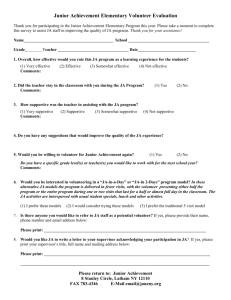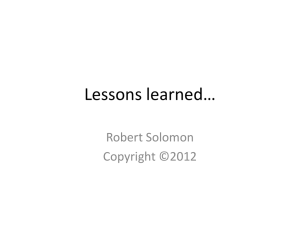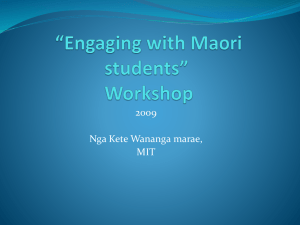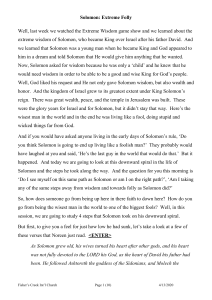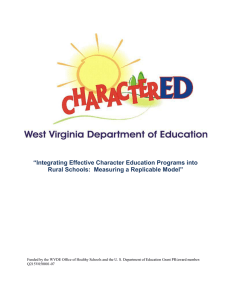Creating-a-School-Community
advertisement
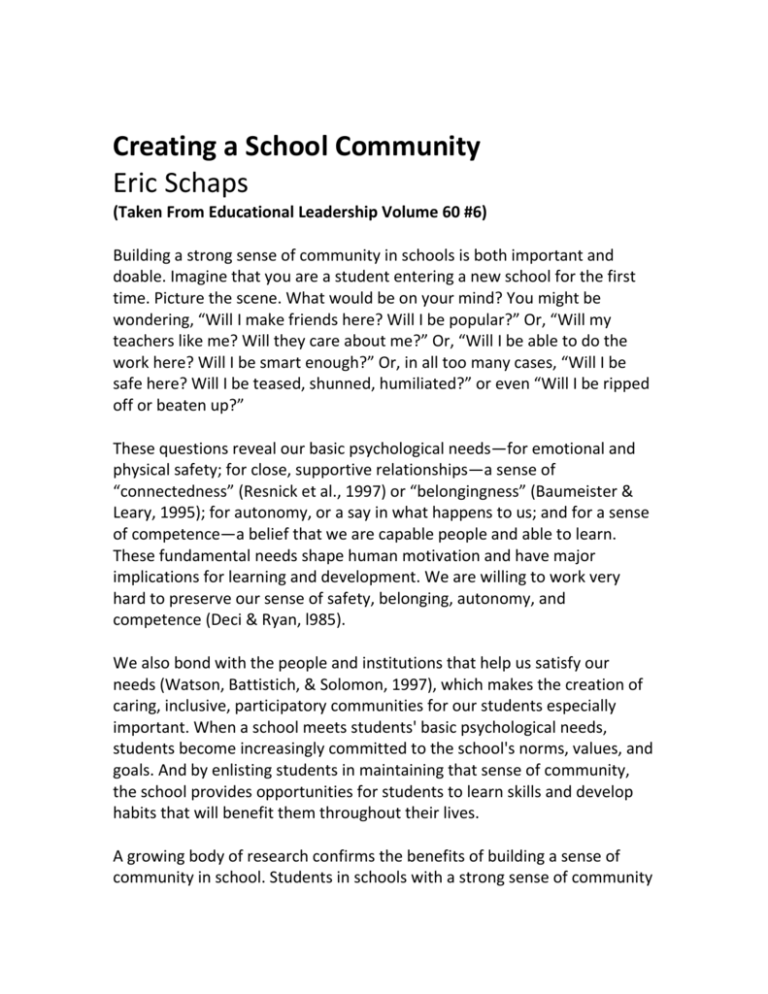
Creating a School Community Eric Schaps (Taken From Educational Leadership Volume 60 #6) Building a strong sense of community in schools is both important and doable. Imagine that you are a student entering a new school for the first time. Picture the scene. What would be on your mind? You might be wondering, “Will I make friends here? Will I be popular?” Or, “Will my teachers like me? Will they care about me?” Or, “Will I be able to do the work here? Will I be smart enough?” Or, in all too many cases, “Will I be safe here? Will I be teased, shunned, humiliated?” or even “Will I be ripped off or beaten up?” These questions reveal our basic psychological needs—for emotional and physical safety; for close, supportive relationships—a sense of “connectedness” (Resnick et al., 1997) or “belongingness” (Baumeister & Leary, 1995); for autonomy, or a say in what happens to us; and for a sense of competence—a belief that we are capable people and able to learn. These fundamental needs shape human motivation and have major implications for learning and development. We are willing to work very hard to preserve our sense of safety, belonging, autonomy, and competence (Deci & Ryan, l985). We also bond with the people and institutions that help us satisfy our needs (Watson, Battistich, & Solomon, 1997), which makes the creation of caring, inclusive, participatory communities for our students especially important. When a school meets students' basic psychological needs, students become increasingly committed to the school's norms, values, and goals. And by enlisting students in maintaining that sense of community, the school provides opportunities for students to learn skills and develop habits that will benefit them throughout their lives. A growing body of research confirms the benefits of building a sense of community in school. Students in schools with a strong sense of community are more likely to be academically motivated (Solomon, Battistich, Watson, Schaps, & Lewis, 2000); to act ethically and altruistically (Schaps, Battistich, & Solomon, 1997); to develop social and emotional competencies (Solomon et al., 2000); and to avoid a number of problem behaviors, including drug use and violence (Resnick et al., 1997). These benefits are often lasting. Researchers have found that the positive effects of certain community-building programs for elementary schools persist through middle and high school. During middle school, for example, students from elementary schools that had implemented the Developmental Studies Center's Child Development Project—a program that emphasizes community building—were found to outperform middle school students from comparison elementary schools on academic outcomes (higher grade-point averages and achievement test scores), teacher ratings of behavior (better academic engagement, respectful behavior, and social skills), and self-reported misbehavior (less misconduct in school and fewer delinquent acts) (Battistich, 2001). A study that assessed the enduring effects of the Seattle Social Development Project— another elementary school program—on former participants at age 18 found lower rates of violent behavior, heavy drinking, and sexual activity, as well as higher academic motivation and achievement, for program participants relative to comparison group students (Hawkins, Catalano, Kosterman, Abbot, & Hill, 1999). Schools can readily assess the degree to which students experience community in school by asking students how much they agree or disagree with such statements as My class is like a family. Students in my class help one another learn. I believe that I can talk to the teachers in this school about things that are bothering me. Students in my class can get a rule changed if they think that it is unfair. An annual survey of this sort can help assess a school's overall effectiveness and how well specific community- building efforts are working. Unfortunately, schools with a strong sense of community are fairly rare. In fact, most schools that survey students' perceptions of community wind up with mediocre mean scores. Of further concern is the fact that low-income students and students of color usually report a lower level of community in school than do affluent or white students. Many schools appear to be illequipped to provide community for the students who may need it most (Battistich, Solomon, Kim, Watson, & Schaps, 1995). Community-Building Approaches Fortunately, research also suggests that schools can strengthen students' sense of community by adopting feasible, commonsense approaches. Four approaches are particularly beneficial. Actively cultivate respectful, supportive relationships among students, teachers, and parents. Supportive relationships are the heart of community. They enable students from diverse backgrounds to bring their personal thoughts, feelings, and experiences into the classroom. Supportive relationships help parents, especially those who would otherwise feel vulnerable or uncomfortable, take active roles in the school and in their children's education. Emphasize common purposes and ideals. Along with academic achievement, schools with a strong sense of community stress the development of qualities essential to good character and citizenship, such as fairness, concern for others, and personal responsibility. Everyone shares an understanding of the school's values, which then shape daily interactions. Provide regular opportunities for service and cooperation. Students learn the skills of collaboration, develop wider and richer relationships, and experience the many satisfactions of contributing to the welfare of others. Provide developmentally appropriate opportunities for autonomy and influence. Having a say in establishing the agenda and climate for the classroom is intrinsically satisfying and helps prepare students for the complexities of citizenship in a democracy. Several leading program developers have focused on using one or more of these approaches to build community. The more prominent programs include James Comer's School Development Program (http://info.med.yale.edu/comer/index.html), Eunice Shriver's Community of Caring program (www.communityofcaring.org), the Northeast Foundation for Children's Responsive Classroom (www.responsiveclassroom.org), David Hawkins's Seattle Social Development Project (http://depts.washington.edu/ssdp), and the Developmental Studies Center's Child Development Project (www.devstu.org). The Child Development Project, for example, focuses on the regular use of several key activities: Class meetings are useful for setting goals and norms, planning activities, and identifying and solving problems. They are essential for building peer relationships and fostering shared goals in the classroom. Class meetings at the beginning of the year, for example, include a few “unity builders.” Students may bring a favorite toy or memento and discuss it with a partner, who then presents it to the entire class. The class later may collaboratively establish goals for the year (such as “To make our room a safe place for everyone”), shared values (such as “To treat one another with respect”), or shared norms (such as “To make decisions by consensus whenever we can”). A buddies program pairs whole classes of older and younger students for academic and recreational activities. Every older student gets a younger buddy for the year. They get acquainted by interviewing each other, charting ways in which they are alike and different, and sharing their classroom portfolios. During the year, they may read or play math games together, visit museums, work together for a cause, or create a joint journal of their activities. At year's end, they show their mutual appreciation by exchanging thank you notes or gifts that they have made. Buddies programs help create powerful cross-age relationships, teach important social skills, and create a caring ethos in the school. “Homeside” activities are short conversation activities for students and parents or other caregivers to do at home once or twice a month. These conversations, mostly interviews conducted by students with their parents, link school learning with home experiences and perspectives. For 4th grade state history units, for example, students interview their parents about how their family or ancestors first came to their state. Whether family members have lived in the state for 100 years or 100 days, the story of how and why they came to settle there is part of state history and serves to personalize learning for students. Schoolwide community-building activities link students, parents, and teachers; help foster new school traditions; and promote helpfulness, inclusiveness, and responsibility. They can be as undemanding as Family Film Nights, invitations to the entire family to view a feature-length movie at school and perhaps discuss a question related to it within the family. Or the activities can be as challenging as creating a Family Heritage Museum, for which students and their caregivers prepare displays of information and artifacts that tell something about their family heritage. The school then features the displays for a week or two and organizes an evening event so that parents and children can view them together. These activities help educators make significant changes in the norms, practices, routines, and policies that often prevail in a school's hidden curriculum. They provide tools for promoting all stakeholders' experience of community. Some of them—class meetings, especially—may involve new skills that teachers need to learn through additional staff development. Other activities require little or no additional training for implementation.

